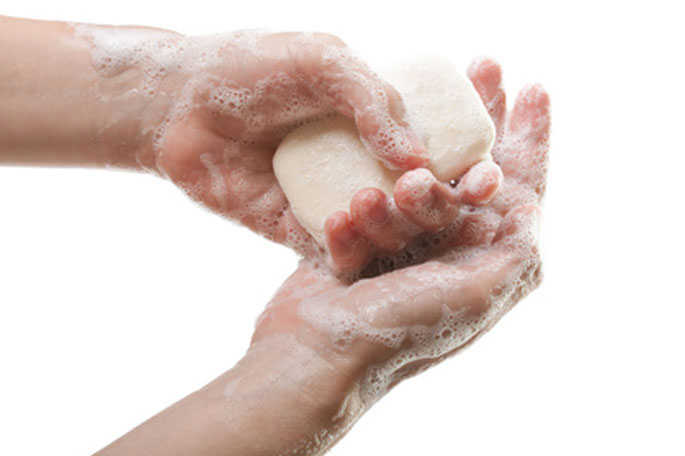51% of a hospitals Intensive Care Unit patients have a serious infection and of those infected 80% of the infections are transferred by touch. (1)
Methicillin-resistant Staphylococcus aureus (MRSA) The staph-bacteria SUPER-BUG is resistant to treatment by the antibiotics called beta-lactams, including methicillin, oxacillin, penicillin & amoxicillin. (2)
Frequently touched surfaces in ICUs & Operating Rooms are heavily contaminated with anywhere from several hundred to over ten thousand colony forming units of infectious bacteria. ( 3) Is it any wonder that the number of Hospital acquired infections has continued to rise?

Who is Affected?
Patients undergoing invasive medical procedures, invasive devices (catheters or ventilators), or with weakened immune systems are most frequently affected with MRSA infections. Such Bloodstream infections, surgical-site infections or pneumonia are potentially life-threatening
however; MRSA outside of Healthcare is snowballing so wash your hands !
Gyms, Day-Care and Schools are increasingly in danger. Begin by practicing good hygiene and disinfecting all potentially high trafficked surfaces.

The CDC recommends:
Scrub Up Keep your hands clean by washing with soap and water or using an alcohol-based hand sanitizer. Shower immediately after exercising.
Cover Your Cuts Cover skin trauma such as abrasions or cuts with a clean dry bandage until healed.
Keep it to Yourself Avoid sharing personal items that come into contact with bare skin (razors, towels). Use a barrier (e.g., clothing or a towel) between your skin and shared equipment such as weight-training benches.
Wipe it Down Use a disinfecting bleach solution to wipe down and disinfect hard surfaces likely to come in contact with skin. Make sure to use clean cloths to avoid spreading MRSA from one surface to another. (¾ cup disinfecting bleach diluted in 1 gallon of water)
What Does the Future Hold?
Pomegranates, Copper, Alligators & Interior Designers?
Pomegranates, famous for their jewel-like seeds, whose rich antioxidant stores may help prevent heart disease and certain types of cancer
A group of Kingston University researchers in London found that a mixture of pomegranate-rind extract, copper salts, and vitamin C can significantly reduce the growth of some common hospital bacteria. The fruit could be a new weapon in the battle against methicillin-resistant Staphylococcus aureus (MRSA), which can cause serious skin, blood, and soft-tissue infections. The high levels of antimicrobials in pomegranate rind that protect the fruits flesh from harmful bacteria might do the same for humans Cara Birnbaum (6)
Antimicrobial Copper touch surfaces kill the bacteria that cause infections where they lie. Antimicrobial Copper surfaces are the most effective antimicrobial touch surface and are ideal for the healthcare environment where their inherent, continuous ability to kill bacteria will supplement infection control measures.(7)
Alligators often engage in violent fights over territories and mates, and scientists have puzzled over why their wounds rarely get infected. Now researchers think the secret lies in the reptiles blood. Chemists in Louisiana found that blood from the American alligator can successfully destroy twenty three (23) strains of bacteria, including strains known to be resistant to antibiotics. (8)
How do Interior Designers fit into this discussion?
1. By writing a specification for Hospital Operating Rooms & ICU Clean Rooms that insures near perfect moisture conditions, Relative Humidity and PH Factor of the typical concrete slab substrate.
2. By specifying adequate Vapor Barriers at the correct location for your Concrete mix, climate and end product. (Many topical surface products, designed especially for healthcare, were created to solve this over sight)
3. By reducing rising damp and moisture penetration by designing Operating rooms and ICU Clean Rooms in above grade locations.
4. By specifying an impregnable floor finish that is highly Stain Resistant as lack of this feature adds greatly to high maintenance costs. Welded Seams and/or penetrable surfaces invite MRSA issues.
5. By recommending a product that meets the expanded need for a seamless, monolithic , non-permeable surface with the superior good looks demanded by the discerning healthcare consumer.
6. By keeping in mind the increased need for superior, effective sterilization methods (past, present and possible future) and designing accordingly. Use an integrated, fusion-sealed, Floor-Cove-Wall system to insure over 48 height of continuous protection throughout the OR or ICU. (9)
7. By paying special attention to the Operating Circle in ORs with regard to Heavy Rolling Loads and the continuous bond required for a Life Span of over 20 years with limited repairs and sealing requirements.
References:
[1] (JAMA, 2009; 302(21)).
[2] Dr. Philip Tierno
[3] (JAMA, 2009; 302(21)).
[4] Dr. Philip Tierno
[5] CDC What to do about MRSA, 2010
[6] Pomegranates Packing a Punch,June 25, 2010
Photo: Rebecca Hale, NGM
[7] Kleven RM et al, 2007 Invasive Methicillin-Resistant Staphylococcus aureus Infections in the United States. JAMA 298(15):1763-1771
[8] Amitabh Avasth National Geographic News April 7, 2008
[9] Floorazzo MATS, Inc. Rich Ruhlin 781 573 0218 http://www.matsinc.com [email protected]
Resources for Healthcare Providers
CDC Guidelines: Management of Multidrug-Resistant Organisms In Healthcare Settings, 2006 [PDF 233 KB] available for download.
CDC, Questions and Answers about Methicillin-Resistant Staphylococcus aureus (MRSA) in Schools,http://www.cdc.gov/Features/MRSAinSchools/
Recent research on MRSA prevention
New England Journal of Medicine: Intervention to Reduce Transmission of Resistant Bacteria in Intensive Care
New England Journal of Medicine: Veterans Affairs Initiative to Prevent Methicillin-Resistant Staphylococcus aureus Infections





